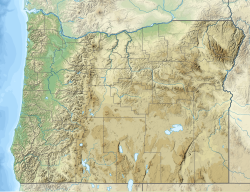| Rattlesnake Formation | |
|---|---|
| Stratigraphic range: Miocene-Late Pliocene | |
 The caprock in this photo (near Picture Gorge) is the ignimbrite layer | |
| Type | Sedimentary and igneous |
| Overlies | Mascall Formation, Columbia River Basalt Group |
| Area | John Day Valley |
| Thickness | 700 feet (210 m) |
| Lithology | |
| Primary | Fanglomerate, siltstone |
| Other | Tuff (ignimbrite) |
| Location | |
| Coordinates | 44°30′N 119°36′W / 44.5°N 119.6°W |
| Approximate paleocoordinates | 44°30′N 116°54′W / 44.5°N 116.9°W |
| Region | Oregon |
| Country | |
| Extent | eastern Oregon |
| Type section | |
| Named for | Rattlesnake Creek |
| Named by | J. C. Merriam |
| Year defined | 1901[1] |

The Rattlesnake Formation is a Miocene to late Pliocene geologic formation found along the John Day River Valley of Oregon, in the Western United States.
- ^ Merriam, J. C., 1901. A contribution to the geology of the John Day Basin, Oregon: Univ. Calif., Dept. Geol. Sci. Bull., v. 2, p. 269-314

